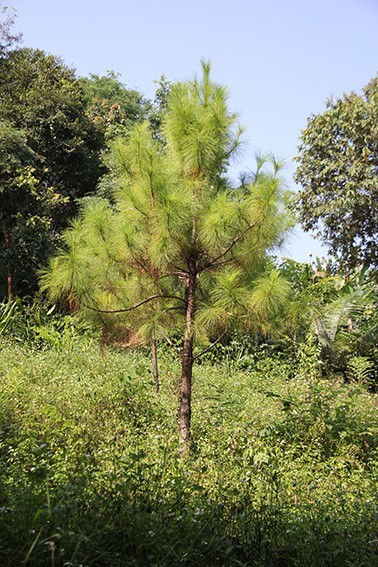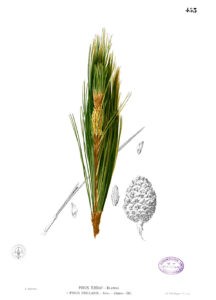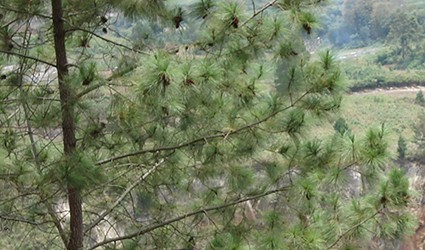Scientific names: Pinus kesiya and Pinus merkusii
English common name: Pine
Lao name: Pek
Plant family: Pinaceae (Pine family)
Pines belong to a group of plants called conifers. Conifers are vascular plants (meaning they have veins for transporting water and nutrients) and their seeds are contained in cones. They appeared on Earth 300 million years ago, well before plants with more ‘typical’ flowers and fruit. All of them are woody, they are generally trees, though sometimes shrubs, and they constitute the majority of wood used for timber in Europe and North America. They are not well represented in the flora of tropical countries, but there are two species of pine trees in the mountainous regions of the Indo-Chinese peninsula: Pinus merkusii Jungh. & de Vriese and Pinus kesiva Royle ex Gordon.

Young Pinus kesiya tree in the arboreatum at Pha Tad Ke.
These pines are characterised by their long, fine, rigid, and pointed leaves, called ‘needles’, which are always green. They are monoecious, which means that the male and female organs are on the same tree. Pollination happens thanks to the wind. The seeds develop inside a protective cone, known as a pine cone, and are spread about by birds and small animals.
Pinus merkusii is characterised by its two-stranded needles and its dark brown, almost black, cone. It can be found mostly in Cambodia, generally below 1000 m.
Pinus kesiva is recognizable by its three-stranded needles and its yellowish cone. It is dominant in Laos and Vietnam, and is found between 1000-1700 m above sea level.
These two pines are called pek in Lao and thong in Vietnamese. However, one also hears the name khoua in Lao. In Thai they are known as kia plueak daeng (P.kesiya) and kia plueak dam (P.merkusii).
Both species are still used for their oleo-resin and for their wood, although neither are of particularly good quality, particularly when compared to the wood and oleo-resin extracted from European and American pine trees. Unfortunately that hasn’t prevented exploitation and the disappearance of numerous pine forests in the region. In Laos, as in neighbouring countries, some small scale reforestation is being attempted with these two rapidly-growing pine trees. Unfortunately it seems that these coniferous trees, like the eucalyptus planted with the same intent, cause deterioration in the soil. In the 1960’s the French botanist Vidal made this observation.

Botanical illustration of Pinus kesiya from the Flora of the Philippines. Image from Wikimedia Commons.
He also notes a remedy made from the wood of Pinus merkusii. This preparation is called fon (the same word as for ‘rain’ in Lao) and is created by grating a piece of wood on a stone, steadily adding a little water to gather the particles. This powder, related, among others, to the bark of cinnamon and to the wood of si khai tone, provides a ‘remedy for wind’(ya lom) and is to be taken in cases of bloating and constipation.
In the Lahu communities of Thailand, Anderson observed another recipe, this one to aid with urinary tract trouble. It is made by boiling pandanus fruits with a Pinus merkusii cone, and, in order for the medication to be effective, it is necessary to place three stones, taken from under a bridge, into the boiling solution.
Text by Dr Biba Vilayleck, PTK Ethnobotanist. Translation from French kindly done by Gillian Marshall, with edits by Bryony Smart, PTK Ethnobotanist.
Image credits :
Pinus kesiya photograph: By Bryony Smart
Pinus kesiya illustration: By Francisco Manuel Blanco (O.S.A.) – Flora de Filipinas […] Gran edicion […] [Atlas II].[1], Public Domain, https://commons.wikimedia.org/w/index.php?curid=1614514
Pinus merkusii: By Mohd Fahmi on Flickr – Flickr, CC BY-SA 2.0, https://commons.wikimedia.org/w/index.php?curid=6015512

Pinus merkusii. Image from Wikimedia Commons.


